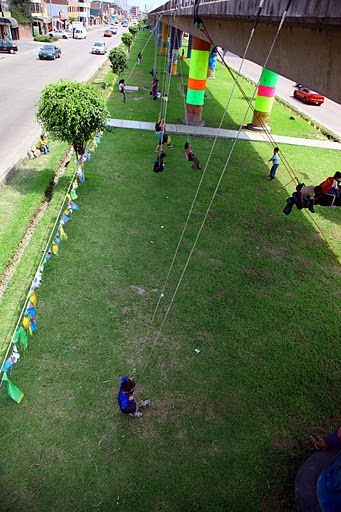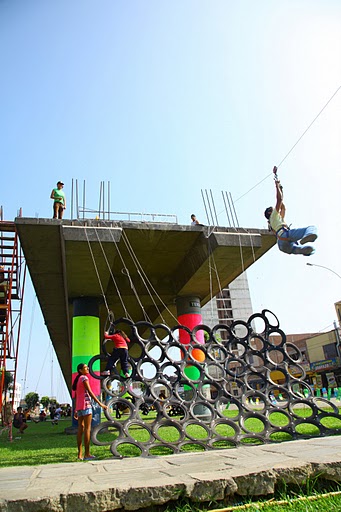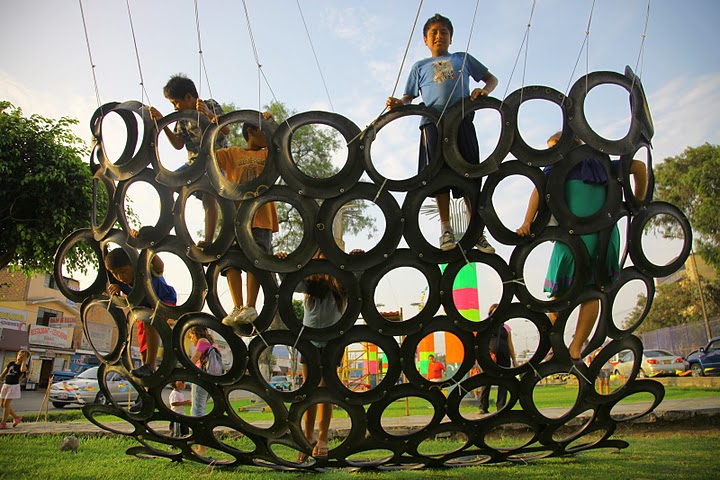Aug 01 2020, by Fleetwood Urban (Marketing)
Rus Lima (Ghost Train Park)
Where: Lima, Peru
Design Team: Basurama (Madrid)
Client: Spanish International Development Cooperation Agency
Opened: 2010
Started in 1986, but never finished, it was an abandoned railway line for over twenty years. That all changed in 2010 when Rus Lima, otherwise known as Ghost Train Park, opened following a multinational collaboration between the Spanish-based Basurama and a team of local students and street artists. An acclaimed example of recycled public spaces, it has been featured everywhere from National Geographic to FastCompany and, ten years on, continues to rank highly on any search for ‘world’s coolest play grounds’.


“(The abandoned train line) was to be a monument to neoliberal productivity, orderly progress and convenience. Now it’s a messy and exciting world of trash for kids. The delirious use of colours and refuse at such an exhilarating scale is exciting.”
faslanyc, Landscape Designer & Blogger
The Team
Commissioned by the Spanish International Development Cooperation Agency (AECID), the Ghost Train project drew together creative minds on both sides of the Atlantic Ocean. The vision for the project was created by urban design collective, Basurama, with the final works and structures delivered by local architecture students and ‘artivists’ (street art activists) in Lima. Basurama was formed in 2001 at the Superior Technical School of Architecture in Madrid. Since then, it has become synonymous with innovative recycling projects reusing everything from scrap metal and cardboard boxes, to old speakers and car tyres, to garbage washed up on beaches. Their provocative works feature across Europe and Latin America, including the Dominican Republic, Mexico, Argentina, Chile, Brazil and Peru.
The Brief
In the mid-1980’s, officials in the Peruvian capital of Lima approved construction for a series of towering concrete columns and overpasses in the Surquillo district. They were supposed to be part of the all-new electric train network, ‘el Metropolitano’, but when the money ran out the entire project was abandoned. Its remnants remained as a jarring reminder of the failure for over two decades until the area was identified by AECID as part of a larger project known as Residuos Urbanos Sólidos, or Solid Urban Waste. Focused on supporting local artist networks and repurposing abandoned areas of cities, the goal was to transform the derelict site into a vibrant community space.

The Challenge
There was tremendous sensitivity surrounding the project, given the controversy that had shadowed the site since the 1980s – a political promise that was never fulfilled. It meant engaging the local community was absolutely essential. The project’s other great challenge was financial. The budget was minimal, bordering on non-existent. Yet from adversity often grows opportunity, and it provided the perfect conditions for just the type of recycling-based solution Basurama is renowned for. In the end, the hard cost for the entire transformation is rumoured to have been just €1,500 (AUD$2,500). True or not, it was certainly delivered on a shoestring.
The Design
The vision for Ghost Train Park was driven by substance, not style. While far from the most aesthetically refined of public spaces, it’s unquestionably one of the most unique, oozing youthful attitude and a distinct urban grunge. Roughly 1,500 metres from end to end, the precinct follows a grassy median strip separating busy north and southbound traffic lanes. Closer inspection reveals a recycling lover’s utopia. Swings, slides, ziplines and climbing frames – mostly repurposed from old ropes, cables, tyres and car parts – hang off the towering concrete columns and steel elevated railway structures, all surrounded by an eclectic open-air gallery of local graffiti art. Some of the striking artworks stand over four metres high. The other unifying design feature is the kaleidoscopic use of fluorescent painted bands on the six-metre high concrete pillars. Vibrant hues of pink, yellow, green and orange scream out for attention – bold, brash and truly unmistakable.
Like to know more about the Ghost Train project?
You can read the official case study from it creators at Basurama here.
*ALL photos on this page are credited to Playscapes by Paige Johnson.
Awards
2010 – Good Design Awards (Public, Cultural and Educational Facilities)
2010 – International Architecture Awards – Best Global Design
2011 – Children’s Environmental Society Design Incentive Award
Like to know more?
To learn more about the Hakone Open-Air Museum and its striking collection of outdoor artworks and structures, you can visit their website here.
*ALL photos on this page are credited to Abel Erazo in David Basulto’s ArchDaily article.



